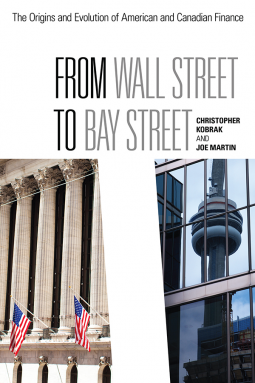
From Wall Street to Bay Street
The Origins and Evolution of American and Canadian Finance
by Christopher Kobrak and Joe Martin
This title was previously available on NetGalley and is now archived.
Send NetGalley books directly to your Kindle or Kindle app
1
To read on a Kindle or Kindle app, please add kindle@netgalley.com as an approved email address to receive files in your Amazon account. Click here for step-by-step instructions.
2
Also find your Kindle email address within your Amazon account, and enter it here.
Pub Date May 15 2018 | Archive Date Mar 12 2018
University of Toronto Press | Rotman-UTP Publishing
Talking about this book? Use #FromWallStreetToBayStreet #NetGalley. More hashtag tips!
Description
The 2008 financial crisis rippled across the globe and triggered a worldwide recession. Unlike the American banking system which experienced massive losses, takeovers, and taxpayer funded bailouts, Canada’s banking system withstood the crisis relatively well and maintained its liquidity and profitability. The divergence in the two banking systems can be traced to their distinct institutional and political histories.
From Wall Street to Bay Street is the first book for a lay audience to tackle the similarities and differences between the financial systems of Canada and the United States. Christopher Kobrak and Joe Martin reveal the different paths each system has taken since the early nineteenth-century, despite the fact that they both originate from the British system. The authors trace the roots of each country’s financial systems back to Alexander Hamilton and insightfully argue that while Canada has preserved a Hamiltonian financial tradition, the United States has favoured the populist Jacksonian tradition since the 1830s. The sporadic and inconsistent fashion in which the American system have changed over time is at odds with the evolutionary path taken by the Canadian system. From Wall Street to Bay Street offers a timely and accessible comparison of financial systems that reflects the political and cultural milieus of two of the world’s top ten economies.
Christopher Kobrak was formerly a professor and the Wilson/Currie Chair of Canadian Business and Financial History at the Rotman School of Management and a professor of finance at ESCP Europe, Paris.
Joe Martin is the Director of the Canadian Business and Financial History Initiative at the Rotman School of Management as well as President Emeritus of Canada’s History Society.
Advance Praise
“Despite their close proximity and longstanding economic ties, the United States and Canada are rarely studied in tandem. In this sweeping, erudite history of financial history in North America, Christopher Kobrak and Joe Martin put the two nation’s divergent histories in productive dialog with one another. The results are fascinating and timely. When seen in each other’s reflection, the financial history of both countries look altogether different than when studied in isolation. From Wall Street to Bay Street is an exemplary work of comparative history. It deserves a wide readership on both sides of the border.”
Stephen Mihm, Department of History, University of Georgia.
“The Kobrak/Martin book serves admirably as a reminder of the importance of the financial system in a nation’s economic development. It also provides historical context for the ongoing effort to successfully manage contemporary and future challenges and opportunities.”
“L.R. (Red) Wilson, O.C., Chancellor Emeritus, McMaster University
“Anyone seeking for an answer how Canada's financial system remained relatively immune to the meltdown of American finance after 2008 needs to read this book. The authors offer a long-term perspective on the tradeoffs between relative stability (Canada) and the often reckless but dynamic financial innovation (America) in this comparative, long-term perspective. Whatever the choice, the authors make clear that the financial architecture of any country is intricately embedded in its historical choices and general value system where the “seeds are sown and fields are watered long before the crops are harvested,” sometimes, as those crops and consequences have devastating effects.
Jeffrey Fear, Programme Coordinator: Global Markets, Local Creativities (GLOCAL)
“A clearly written and cogently argued study, written for both the generalist and the specialist, that yields important insights into the historical development of the financial sectors of Canada and the United States. History might not always repeat itself, but learning from these insights would help the two countries find a better balance between financial innovation and financial stability, thereby maintaining vibrant economies while avoiding another financial crisis that leads to a Great Recession.”
George Bain, Queen’s University Belfast.
Marketing Plan
- International Review Mailing
- International Advertising
- Author Interviews
- E-Marketing Campaign
- Academic Journals
- Conferences
- International Review Mailing
- International Advertising
- Author Interviews
- E-Marketing Campaign
- Academic Journals
- Conferences
Available Editions
| EDITION | Paperback |
| ISBN | 9781442616257 |
| PRICE | $34.95 (USD) |



